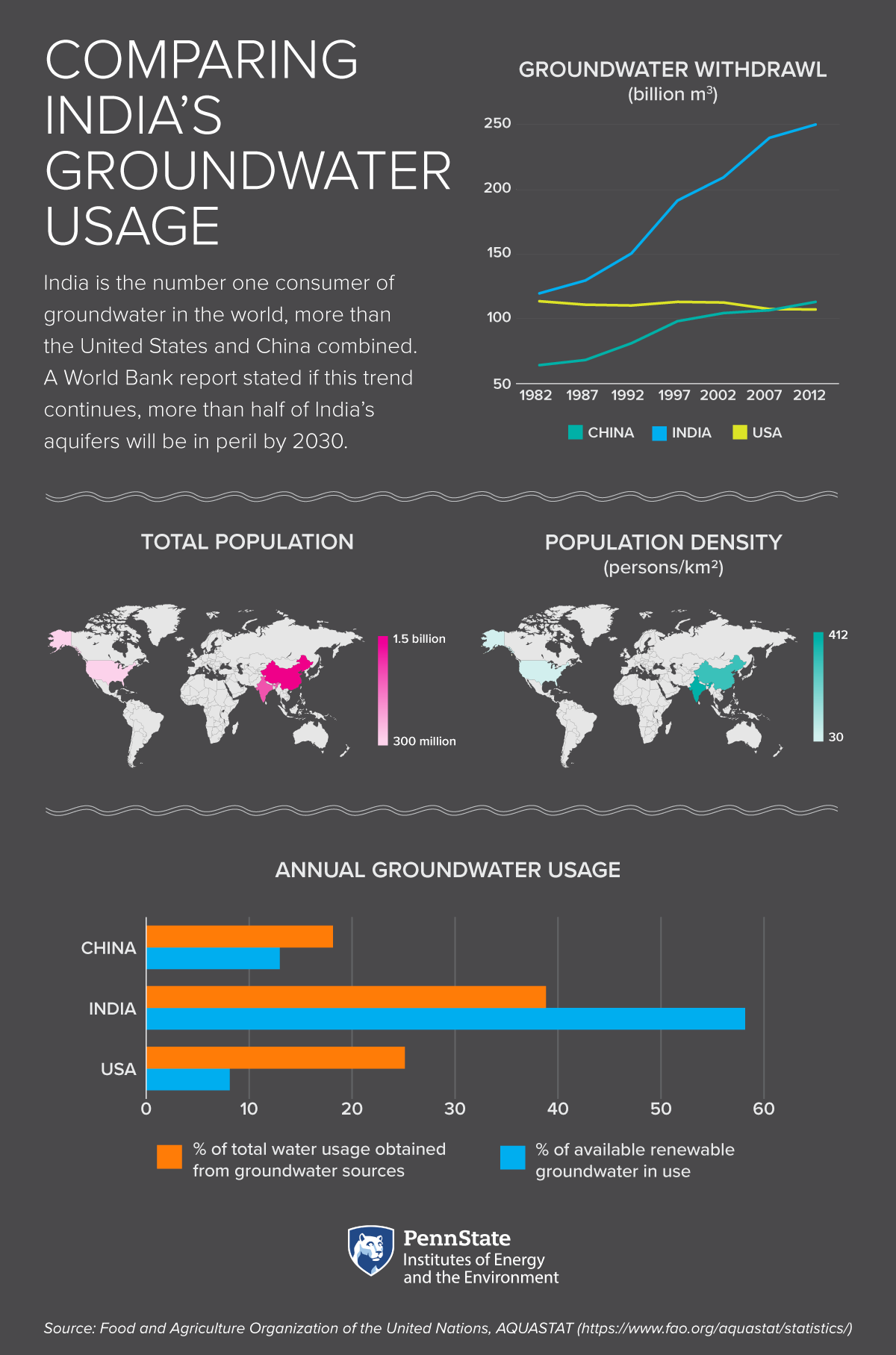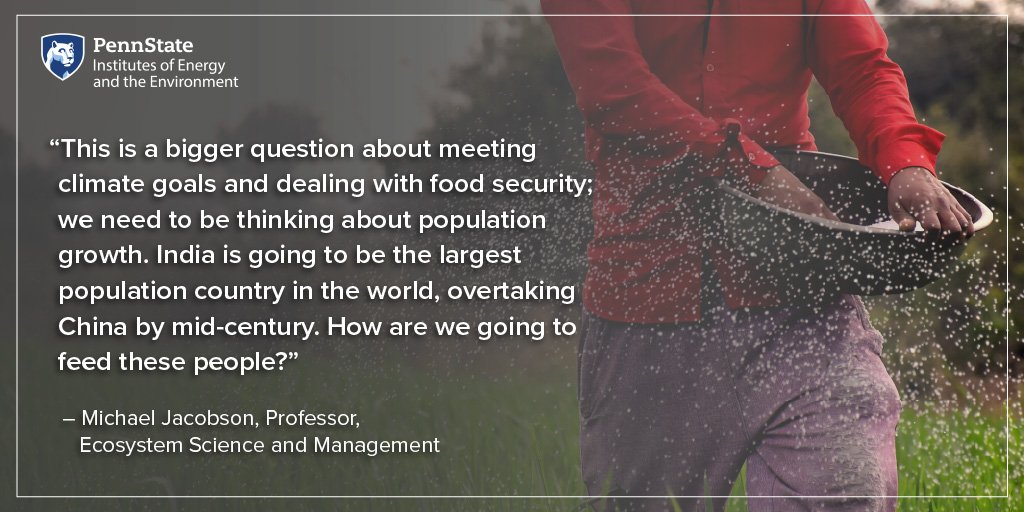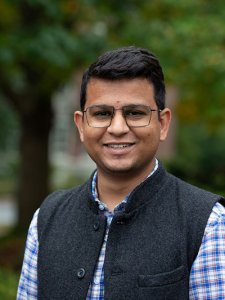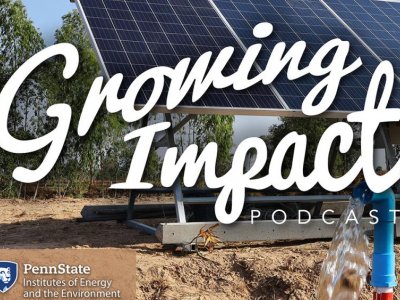The groundwater levels in India are consistently dropping year to year. In fact, India uses more groundwater than any country in the world. However, it is also a nation that lacks water availability, and its population continues to grow. A team of researchers is analyzing how an Indian government policy aimed at installing and using solar irrigation pumps in agriculture may further lower groundwater levels, impact energy use, and help or hinder food production in India.
Transcript
INTRO: India is the largest groundwater consumer in the world, which is like, higher and beyond the second and third, which is the U.S. and China combined. We consume 250 billion cubic meters per year.
HOST: Welcome to Growing Impact, a podcast by the Institutes of Energy and the Environment at Penn State. Growing Impact explores cutting-edge projects of researchers and scientists who are solving some of the world’s most challenging energy and environmental issues. Each project has been funded through an innovative seed grant program that is facilitated through IEE. I’m your host, Kevin Sliman.
On this episode of Growing Impact, I speak with a team of researchers who are examining the consequences of a solar irrigation pump (SIP) policy in India. Their seed grant project is titled “Analyzing the Adoption of Solar Irrigation Pumps in India within the Food-Energy-Water Nexus: Implications for Carbon, Groundwater Depletion, and Agricultural Productivity.” Through this project, the team is analyzing the policy to determine how it may impact groundwater consumption, energy usage, and food production in a country with a rapidly growing population and some of the fastest depleting groundwater reserves.

View Larger
HOST: Today, on Growing Impact, I have a team of researchers who is working on the food-energy-water nexus and the involvement of solar energy in that process. I’ll let the team introduce themselves.
Danny Brent (DB): My name is Danny Brent. I'm an assistant professor in the Department of Agriculture, Economics, Sociology and Education here at Penn State. And my general interest is environmental economics and the focus on water.
Mike Jacobson (MJ): Mike Jacobson, professor of forest resources in the Department of Ecosystem Management in the College of Agricultural Sciences. And my work related to this project is on water-energy-food security and thinking about the integration of these sectors, so we call it water-energy-food nexus. I'm working primarily in Africa on this, but there are a lot of lessons we can learn from India.
Praharsh Patel (PP): Hi, my name is Praharsh Patel, and I'm a PhD student in Energy and Environmental Economics Program in the College of Agricultural Sciences. And I work on environmental economics with a special interest in intended and unintended consequences of economic policies.
HOST: I'd like to welcome the team to Growing Impact.
DB: Thanks for having us
MJ: Likewise, good to be on with you.
PP: Yeah, Kevin. Happy to be here.
HOST: What is the background of this project?
DB: So Praharsh is from Gujurat, and they have some really severe groundwater depletion issues there. And we're looking at this policy that was focusing on providing solar irrigation to farmers. And we're interested in what the potential implications would be for groundwater. So the solar panels can reduce carbon, provide more stable electricity for irrigation. So there's a lot of benefits, but we were also concerned about perhaps some of the unintended consequences in terms of groundwater depletion. And try to figure out again what some of the costs and benefits, particularly some of these unintended consequences of the policy really got us interested in this idea in the first place.

HOST: What inspired you to look at irrigation needs in India?
PP: I would say like I belong to a farming community in India. And it's more of a degree of personnel interest in the subject. So I have first-hand experience how the irrigation is so important for the farming community, especially in the arid and semi-arid parts where I belong. That’s Gujarat. And groundwater especially is very much important for socio-economic development of entire communities and sustainability of not just the food systems, but also the people. However, since groundwater is very much dependent on a stable resource, there has been over-exploitation of groundwater in the last few years, very much brought on by the free energy access to the farmers. And you might be surprised, but India is the largest groundwater consumer in the world, which is higher and beyond the second and third, which is U.S. and China combined. We consume 250 billion cubic meters per year. That’s like higher than 20% of combined groundwater consumption of U.S. and China. And still we are just around the 30% of total number of irrigation access to the farmers. And we need to further expand variation expansion, which will put energy access in question. And also like a big question on groundwater sustainability. That's very much interesting from my side to look at the entire perspective of like food security through energy and water nexus.
HOST: You spoke a little bit about India, Praharsh. Could you talk about what factors influenced your decision to use India as a location?
PP: Firstly, the groundwater situation was very much a driving factor here. The groundwater depletion, where I was working before I joined my PhD. The severity is such that we are in a depletion of almost like 10 to 15 feet every year. That's like the world’s largest groundwater depletion happening ever. And again, that is also a need for sustaining the agriculture production. And so there is no policy that we can impose on people to just to stop the groundwater usage. That's where this solar irrigation was an interesting idea because during that farmers are provided with solar panels that can connect to the grid. And they can actually sell the surplus energy they are producing. And now this kind of creates the opportunity cost for the farmers to not inefficiently use the energy that they are getting for free. And that was the most exciting factor, which is why we kind of focused on especially Gujarat and Indian scenario of solar irrigation promotion.
HOST: From a greenhouse gas lens, why are solar irrigation pumps an important step forward for India?
MJ: Obviously, everyone wants to reduce their reliance on fossil fuels. So that's the simple answer. And India is one of those countries that are in a predicament. Although they have good coal supplies, they are also dependent on imports for other types of fossil fuels. So the bottom line is, if they can be more independent from the fractious global economy right now with fossil fuel activities, like the war in Ukraine affecting supplies. Solar panels provide independent energy sources. So that's another reason. Then obviously, we have to think about the other benefits, not just the greenhouse gases—like agricultural production, the energy savings, and hopefully on more efficient water use.

HOST: In the abstract, it talks about that there are hindrances to the adoption of solar irrigation pumps. Could you talk a little bit about what's hindering the adoption of solar irrigation pumps?
PP: You find that there are different types of issues. The first time for most is the finances. Solar system is still a very much expensive affair for the farmers who are still very much on minimal incomes. Secondly, although they are providing a huge subsidy. So this team, which we are talking about, (UNCLEAR), which was a state government’s team. They're providing almost ninety-five percent finances through direct or indirect means. Still those managing the rest of the 5% are still difficult for a few farmers. Second that comes into the picture, is like a local know-how of the technology. The solar is being a very sophisticated technology, and there are so many components, especially when it goes to the grid connection. You need to manage all the electrical systems, from the fine tuning to the micro grids. And this was a huge challenge in adoption. (UNCLEAR) was more of a social aspect which was like for adoption of grade-level solar, there has to be almost 70% consensus among the same feeder farmers, the farmers in the same locality to adopt the system. And most of the farmers, as we have seen in most of the technological adoption, people like to wait and watch. They would like to wait and see how it works for others before themselves are interested and adopt the things. So there was also a component where farmers were skeptical about the potential benefits, potential outcome of the new technology for them. And they were not very excited to adopt in the first place.
DB: In certain places that some of the components, I think in particular the copper wiring were being stolen and or other parts were breaking down and they didn't have technical workers to be able to go and fix them. So it's really varied from region to region. So in some places, they're generating very little electricity from these panels because there were some breakdown. Either there was theft and components were hard to replace or something was breaking and they didn't have anyone to fix it. In other places, it was running a lot smoother. So we're still in the process of going to analyze the electricity data so to see how much electricity these panels are actually producing. And I think that we're probably going to find that there is really wide differences from region to region. And so it just gets to this idea that you may have a really nice policy, it sounds good. But when you go to implement it, that implementation and the people on the ground who are actually running it, which may vary from place to place, really matters.
HOST: If and when solar irrigation pumps are being used in India and it becomes a widespread, what are concerns about groundwater management?
DB: The way that you need to answer this question is to think about what the solar irrigation pumps are replacing. So the first category, and again, this is the primary category of this policy—but not necessarily other solar irrigation pump policies—is that it's just replacing an existing grid-connected pump that's powered by electricity. And so the difference here, I think there's two big changes. The first is that you typically get water access during the day and for a longer period of time. So most of these farmers got water for eight hours a day, or eight hours during the day and often it would be at night. And when you adopted the solar irrigation pump, I think it was expanded to 12 hours. And again, it was during the day when the solar pump waste producing energy. The second factor for if you are replacing a grid-connected pump is that now there's an opportunity cost for using the water. And this does vary from different farmers on grid connections. So some farmers just pay a flat fee so there's no marginal cost for irrigation pumping, using the electricity to pump groundwater. So it doesn't matter if you pump a lot or a little. You pay the same electricity charge. Now with the solar irrigation pum, whatever you don't use for irrigation, you can send back to the grid and get paid for it. So this adds an incentive for conservation. So that's sort of what's going on the grid-connected farmers, if you're replacing a grid-connected pump. Then you also have farmers who are not connected to the grid and a solar irrigation pump could replace—either you don't have any groundwater access or a diesel pump, which is really expensive to use. In this case, it probably makes pumping groundwater cheaper. In some areas if we’re replacing grid-connected pumps for farmers that are paying a flat fee, the solar irrigation pumps may increase the incentive to conserve groundwater. If you're replacing an expensive pump or adding a pump to a place where there wasn't a pump before, solar irrigation pumps that again have a zero marginal cost or a zero incremental cost for pumping groundwater may really increase the demand for groundwater in those areas and then exacerbate any groundwater depletion. So I think it's going to be really important to harmonize groundwater policy with solar irrigation policy. And again, this is one from our perspective, the most interesting elements of this topic in general as these trade-offs between energy use, agricultural production, and groundwater conservation.
MJ: I'll just add it's not just the trade-offs on whether they overconsume water, but it's also on how they, as Danny just mentioned, decide on whether or not to grow more crops, to expand the land, or to change their harvesting or cropping practices. With respect to the water use. That's the whole reason for thinking of integrating this water energy food nexus approach is really the policy governance. The silos of these three sectors, they're not talking to each other. And this is an excellent case in point where the energy policy on solar is not really thinking about the impacts on groundwater and the agricultural impacts, food production, and so on. So yeah, that's why it's complex.
HOST: Who stands to benefit from SIPs?
PP: If I answer that very directly, I would say in current contexts if this grid connection is provided in the way that it is done in Gujurat, the well-off farmers who have the means to adopt all the largest solar plants, they will reap all of the benefits out of it. I have seen a few farmers who are like leave agriculture aside and we will just produce solar energy and make money that is more than double the agricultural production we are making as of now. Whereas the whole point of this policy was like promoting solar irrigation so that even the not-so-well-off farmers, the medium- or lower-income farmers can also reap some benefit in building climate resilience in case they can't produce agriculture due to drought or some climate disaster kind of thing. They have at least some income to fall back on. But it doesn't seem that that's the main outcome as of now. I'm not pessimistic that it's not going to happen, but definitely with adopting more by the small farmers, it will definitely create some more benefit to the all types of farmers if it's implemented in the way it should be.
HOST: Interesting.
DB: Yeah, So I think I remember Praharsh had some—I forget the exact phrase he used—but he said that they're transitioning from being agricultural producers to being small-scale solar plants. And I don't think that that was the goal. That may be a goal in general of trying to have distributed solar on agricultural land. But the goal for, I think for this policy in general, is to basically replace the electricity needs for pumping groundwater. And you did see scenarios where they're four or five times as much capacity as their previous groundwater use would demand. And so they would definitely benefit. They don't necessarily benefit. And there are environmental benefits that they're not necessarily benefiting the way that the policy wasn't ended. One other element that I would be interested in or think about for a larger scale policy was really focusing on these off-grid farmers. Again, they may have more severe groundwater implications if you're really adding irrigation capacity. But if they're not connected to the grid, getting access to solar irrigation, may be a better step than waiting for the electricity grid to come to your area. And again, you can think of it as like a leap-frog technology. So as opposed to waiting for the traditional technology, centralized power plant and transmission lines to reach remote places, you can get decentralized solar irrigation. And again, I think the big question is trying to incorporate groundwater management into that. But otherwise, from food and energy perspective, I think that there are really attractive features of sort of skipping the grid connection and going straight to a decentralized solar.
MJ: But another issue is these people who just absorbing credits so to speak, to feed back to the grid. They also using land for these panels, right? And so that's another issue is the trade-offs with the panels and the land use. There’s other technology called agrophotovoltaics, where you actually can, I think State College, I saw a photo that a day of some sheep under solar panels. And that's the idea where you can grow shade-tolerant crops and pastures under these panels so you get your energy, food, and you can use the panels for water on the same piece of land.
HOST: How will this project help make an impact in India?
DB: The national policy, I think, is still under development. I don t think it's been deployed yet, but I think it'll be really interesting to see the form that it takes again, is it really an energy policy that's trying to just use agricultural land to build solar panels and gradually displace fossil fuels? Is it an agricultural plan to really increase access to irrigation and particularly to places that may not have electrical grid connected pumps? Or again, is it more of like a social welfare plan where providing a constant stream of income to farmers that are vulnerable to all sorts of different shocks on—so it's in some sense like a form of agricultural or farm insurance that even when the crops aren't doing well, you still have it as a revenue stream from the solar panel? And again, that's only going to be the case. It is connected to the grid, and you can sell the electricity back. So there's a lot of different ways where it could impact India. And I definitely am interested to see how it develops and how it's used in other places as well.
HOST: What are the broad implications of solar irrigation for South Asia and Africa?
MJ: This is a bigger question about meeting climate goals and dealing with food security. And these countries in Africa and South Asia have huge populations. I think that is probably the basic thing that we need to be thinking about is population growth. India is going to be the largest population country in the world, overtaking China by mid-century. And Nigeria, for example, in Africa, is going to be the second largest. So, so how are we going to feed these people? The demographics and the population issues are important and solar irrigation to provide this food, at least, and perhaps jobs and other offshoots of technologies and the industry and manufacturing from solar in general, not just irrigation, and also reducing carbon emissions at the same time from dependency on fossil fuel, which is a global issue right now on supplies. I think it shows that this project, as we also working on it in Africa with solar irrigation, can be a small part of this bigger puzzle on dealing with population pressures and food security issues. Yeah. I didn't even mention the water scarce issues in you look at global maps. I mean, these regions are the most water-scarce areas in terms of availability and access, and also the regions that have the least-irrigated agriculture.
HOST: Thank you for spending time on Growing Impact and discussing your research with me.
TEAM: Thanks for having us.
HOST: You’ve been listening to Growing Impact, a podcast by the Institutes of Energy and the Environment at Penn State. I’ve been your host, Kevin Sliman. To learn more about IEE and to hear previous episodes of Growing Impact, please visit iee.psu.edu This has been season three, episode 1. Thank you for listening.










